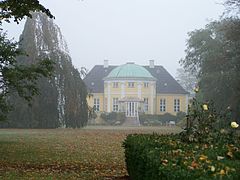Frydenlund
| Fredenslund | |
|---|---|

Frydenlund
|
|
| General information | |
| Architectural style | Neoclassical |
| Location | Rudersdal, Denmark |
| Country | Denmark |
| Coordinates | 55°50′27.34″N 12°33′29.11″E / 55.8409278°N 12.5580861°E |
| Construction started | 1726 |
| Completed | 1729 |
| Design and construction | |
| Architect | Jørgen Henrich Rawert |
Frydenlund is a historic house near Vedbæk north of Copenhagen, Denmark.
The first structure at the site was a hunting lodge built just north of the royal deer park Jægersborg Dyrehave which was established in 1670. It was acquired by Conrad von Reventlow in the 1680s. Originally from Holstein, he now lived at Clausholm Castle and gave the pavilion the name Freudenlund. After his death, the property was passed on to his daughter, Anne Sophie, who married King Frederick IV Morganatically in 1712. From 1722 to 1726, after their second marriage in 1721, which gave Anne Sophie status of queen, court architect Johan Cornelius Krieger carried out an expansion of Frydenlund.
In the first half of the 1740s, the house was put at the disposal of General Charles Christian Erdmann, Duke of Württemberg-Oels along with the Württemberg Mansion in Copenhagen (now Lerches Gård).
King Frederick V refurbished the house and gave it to Crown Prince Christian in 1760. In connection with their marriage in 1764, he gave Frydendal to Queen Caroline Mathilde.It was the preferred hideaway for her and Struense during their love affair. A new wooden mansion designed by Caspar Frederik Harsdorff was built in Lille Dyrehave in 1770.
Harsdorff's mansion was destroyed by fire in 1793. The Crown then sold the estate to Karl Adolf Boheman, a Swedish mystic, Freemason, merchant who worked for the mystic society "The Enlightened of Avignon" on the commission of Prince Charles of Hesse-Kassel. He refurbished and expanded Krieger's old house with the assistance of Jørgen Henrich Rawert.
...
Wikipedia
